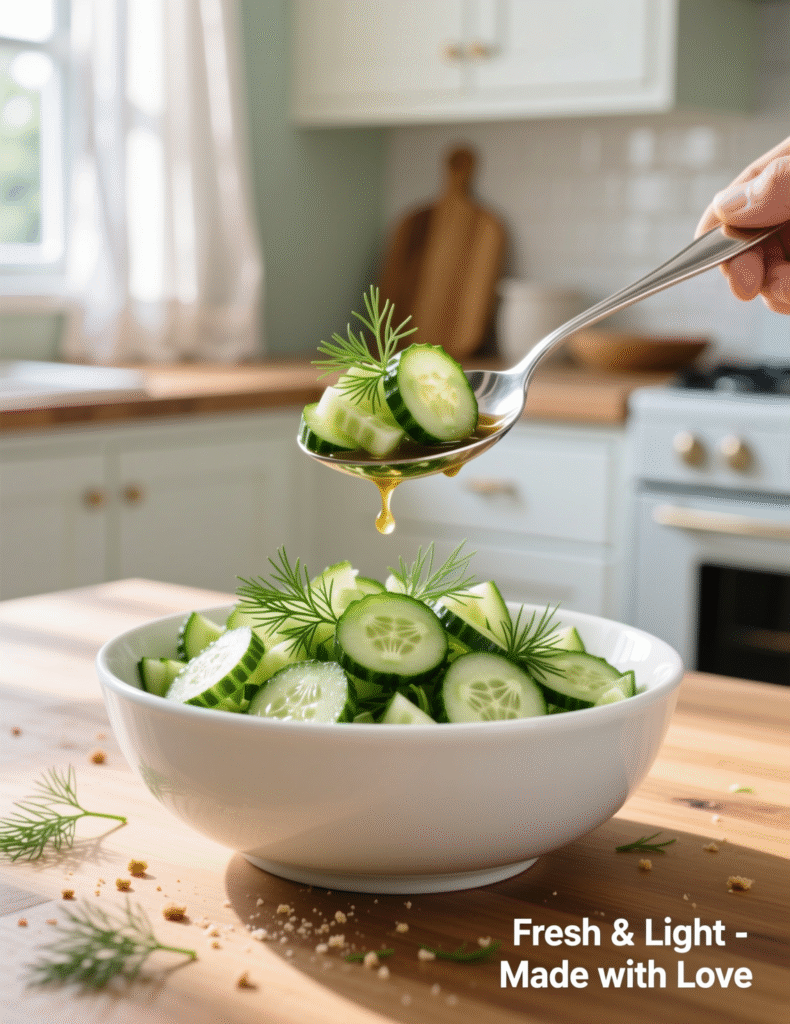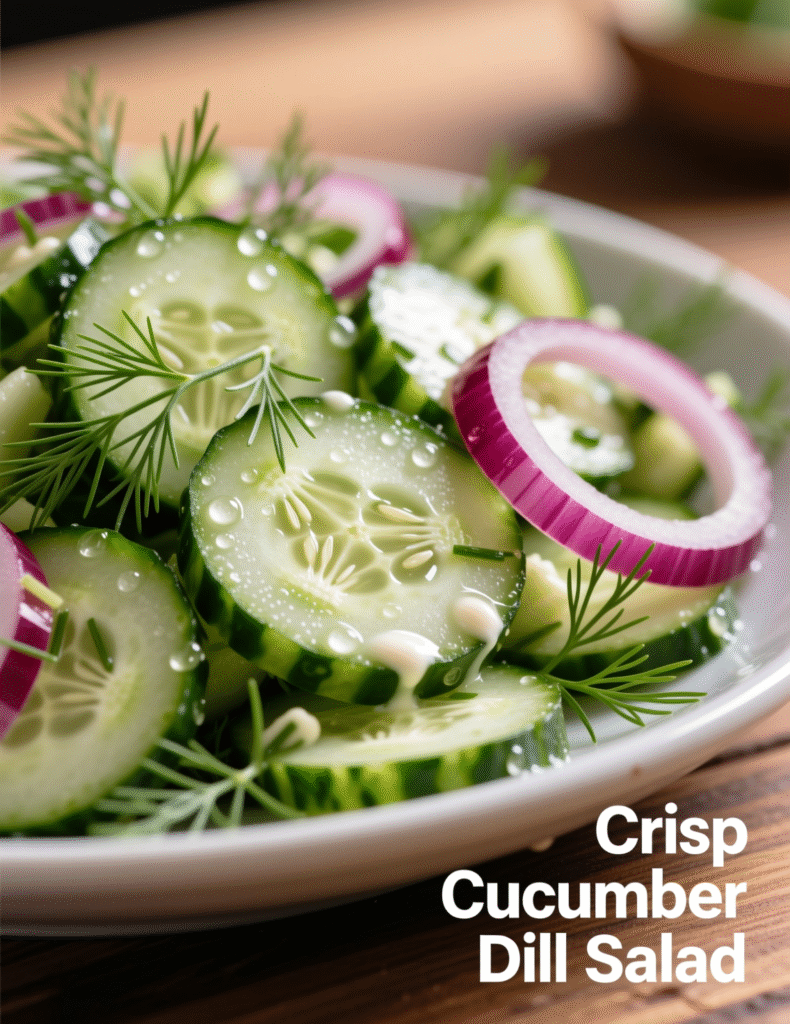If you’ve ever bitten into a salad that just snaps and pops with freshness, you know the difference between a careless chop and a meticulously crafted dish. Today, we’re diving deep into the art and science of a Crisp Cucumber Dill Salad, a dish that’s deceptively simple but requires a chef’s touch to perfect. This isn’t just tossing cucumbers in dill and calling it a day; we’re talking about flavor balance, texture mastery, and presentation that elevates a humble salad to a professional standard.
Why This Salad Matters in Professional Kitchens
Cucumber and dill salads are more than just a side. In fine dining, they’re a palate cleanser, a counterpoint to heavier entrees, and a visual cue of freshness. Studies by culinary institutes have shown that customers associate bright green, crisp salads with overall meal quality and freshness, influencing their perception of the entire dining experience. If you serve limp cucumbers with mushy dill, it’s a silent critique of your technique.
Cucumbers themselves are tricky. They contain up to 95% water, which makes them prone to releasing excess liquid if not handled properly. Dill, on the other hand, is volatile — its oils dissipate quickly, especially when chopped too early. Combining the two needs a balance of timing, technique, and ingredient selection.
Ingredients: The Foundation of Crispness
For 4 servings, you’ll need:
- 2 large English cucumbers, firm and bright green
- 1/4 cup fresh dill, finely chopped
- 1 small red onion, thinly sliced
- 1/4 cup sour cream or Greek yogurt
- 1 tablespoon apple cider vinegar
- 1 teaspoon sugar (optional, balances acidity)
- Salt and freshly cracked black pepper to taste
- 1 teaspoon extra virgin olive oil (optional, adds mouthfeel)
Notice we’re not tossing in garlic or heavy oils. Professional kitchens often keep this salad restrained to let the cucumber and dill sing, not fight.

Choosing the Right Cucumbers
Not all cucumbers are created equal. English cucumbers are ideal for crispness — they have fewer seeds, thinner skin, and a more consistent texture. In contrast, field cucumbers have thicker skins and can be bitter if not peeled. A chef’s trick is to slice a small piece and taste for bitterness. If it’s present, peel carefully, keeping as much flesh as possible to maintain volume.
Prepping Cucumbers Like a Pro
Technique matters. Slice cucumbers with a sharp knife or mandoline to ensure uniform thickness — around 1/8 inch for crunch, or slightly thicker if you want more bite. Uneven slices cook or sweat differently, leading to watery inconsistencies. Some chefs like to sprinkle a little salt on the slices and let them sit for 10-15 minutes, then gently blot excess water. This step enhances crispness, but don’t overdo it — too much salt draws out flavor and can make the salad soggy.
Dill: The Aromatic Hero
Dill is subtle, yet its absence is glaring. Fresh dill fronds are preferred; stems are woody and bitter. Chop finely but not into mush — you want strands that flutter through the salad. Timing is everything. Add dill just before serving, or if prepping ahead, fold in a small portion earlier and reserve some for garnish. This prevents the flavor from fading or becoming overly dominant.
Dressing: Balancing Creaminess and Acidity
A proper cucumber dill salad dressing walks a tightrope between creaminess and acidity. Sour cream or Greek yogurt provides a rich, tangy base. Apple cider vinegar adds a bright snap. Sugar is optional, but in some professional kitchens, a pinch is used to round the sharp edges. Olive oil is optional but can smooth the mouthfeel and slightly temper the tang. Mix gently — aggressive whisking can break down cucumber slices and release water.
Layering Flavors
Think in layers. Start with cucumbers, sprinkle a touch of salt, add onions for bite, fold in dill, then gently toss with the dressing. Avoid overmixing; bruised cucumbers leak liquid, diluting the flavor. Professional chefs often fold ingredients using a wide spatula rather than a spoon. The difference is subtle but noticeable — slices maintain their integrity and look visually appealing on the plate.
Common Mistakes and How to Avoid Them
- Waterlogged cucumbers – Use the salting and blotting technique, and serve immediately if possible.
- Overpowering dill – Always taste as you go. Dill can dominate; balance is key.
- Acid imbalance – Too much vinegar overwhelms; start with a teaspoon and build.
- Texture loss from early mixing – Assemble the salad in layers, add dressing last.
These mistakes are easy to avoid but are surprisingly common, even in high-volume kitchens.
Presentation: More Than Just a Toss
Even a simple cucumber dill salad deserves plating attention. Arrange slices in slightly overlapping rows or in a loose mound for a rustic feel. Garnish with a small sprig of dill, a light drizzle of olive oil, or even a few microgreens for visual contrast. Professional presentation heightens perceived flavor — it’s the psychology of freshness.
Serving and Storage Insights
This salad is best served cold but not icy. Let it rest in the fridge for 10-15 minutes after assembly to allow flavors to marry. Avoid storing for more than 24 hours; cucumbers lose crispness quickly. If prepping ahead, keep dressing separate and fold it in at the last moment. For batch service in restaurants, store cucumbers lightly salted, chilled, and sliced, then dress per order to preserve peak texture.
Nutritional Notes
Cucumber dill salad is low-calorie yet nutrient-dense. Cucumbers provide hydration and vitamin K, while dill offers antioxidants. Yogurt adds protein and probiotics, contributing to gut health. This combination makes the salad not just a side dish but a functional component in a balanced meal plan, particularly appealing in health-conscious menus.
Emerging Trends and Variations
Chefs are experimenting with cucumber dill salads beyond traditional boundaries. Some infuse the dressing with horseradish for a subtle kick. Others add radishes, fennel, or even micro-herbs to enhance complexity. Molecular gastronomy approaches use cucumber gelée or yogurt spheres for texture contrast. Even simple tweaks like using flavored vinegars can modernize the classic.

Case Study: Cucumber Dill Salad in Michelin Kitchens
In multiple Michelin-starred kitchens, cucumber dill salads appear as part of tasting menus. A notable technique involves vacuum-sealing cucumber slices with a touch of vinegar and olive oil, chilling them for 20 minutes, and then folding in fresh dill. The result is exceptional crunch and flavor integration. Professional kitchens stress timing, ingredient integrity, and subtle seasoning — principles every chef should understand.
FAQs for Professionals
What type of cucumber is best for this salad?
English cucumbers are ideal for crispness and fewer seeds.
Can I use regular cucumbers instead?
Yes, peel and deseed them to prevent bitterness and excess water.
When should I add the dill?
Add most dill just before serving to retain its fresh flavor.
How can I prevent the salad from becoming watery?
Salt lightly, blot excess moisture, and dress right before serving.
Can this salad be made vegan?
Yes, use coconut or cashew-based cream instead of yogurt.
Is it better to slice cucumbers thin or thick?
Thin slices (about 1/8 inch) provide maximum crunch without sogginess.
Can I prepare the salad ahead of time?
Prepare cucumbers and onions ahead, but add dressing and dill last.
What is the purpose of the sugar in the dressing?
A pinch balances acidity and rounds out flavors without sweetness.
How should I serve the salad for best presentation?
Serve cold, arrange slices neatly, and garnish with dill or microgreens.
How long does this salad stay fresh?
Best within 24 hours; cucumbers lose crispness if stored longer.
Key Takeaways for Culinary Experts
- Ingredient selection sets the foundation; crispness is everything.
- Timing of seasoning and herb addition profoundly affects flavor.
- Presentation matters, even for a simple salad.
- Professional handling, even in small touches like folding technique, can transform a humble dish into an elevated experience.
- Continuous tasting and adjustment is a hallmark of culinary excellence.
Crisp Cucumber Dill Salad may seem simple, but every step — from slicing to seasoning — is an opportunity to showcase skill. Whether serving four guests or four hundred, applying these techniques ensures consistent, flavorful, and visually stunning results. This isn’t just salad-making; it’s culinary craftsmanship.

Marie Smith is a passionate recipe blogger, sharing easy, delicious, and creative culinary ideas that inspire home cooks to elevate everyday meals with flavor and simplicity.
